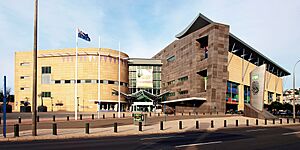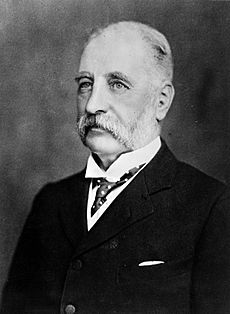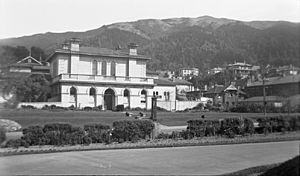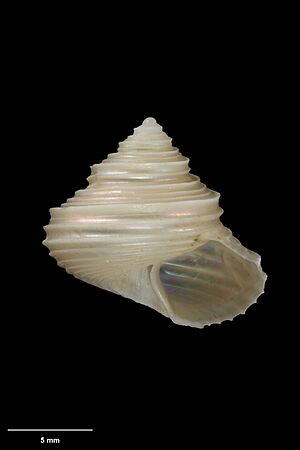Te Papa facts for kids

Front side with entrance in 2009
|
|
| Former name | Dominion Museum and National Art Gallery |
|---|---|
| Established | 1992 |
| Location | Wellington, New Zealand |
| Visitors | 1.5 million (2017) |
The Museum of New Zealand Te Papa Tongarewa, often called Te Papa, is New Zealand's national museum. It is located in Wellington, the capital city. Its name, Te Papa Tongarewa, means 'container of treasures' in Māori. The museum opened in 1998, bringing together two older museums: the National Museum of New Zealand and the National Art Gallery.
Over a million people visit Te Papa each year. In 2023, it was one of the most-visited art galleries in the world. Te Papa works with a special idea called "bicultural philosophy." This means it celebrates both Māori and European cultures in New Zealand. It focuses on the living stories behind its amazing cultural items.
Contents
Te Papa's Journey: A Look at Its History
The First Museum: Colonial Museum (1865-1907)
The very first version of Te Papa was the Colonial Museum. It started in 1865. Sir James Hector was its first director. This museum was built on Museum Street in Wellington. It mainly collected scientific items. But it also gathered other interesting things, like paintings, old objects, and items from different cultures. Many of these items were gifts. In 1907, the Colonial Museum changed its name to the Dominion Museum. It started to collect an even wider range of items.
Joining Forces: Art and History (1930s)
People in Wellington wanted a public art gallery. In 1913, a law was passed to help create a national art gallery in the same building as the Dominion Museum. By 1930, both the Dominion Museum and the National Art Gallery were managed by the same group of people.
In 1934, the National Art Gallery moved into the Dominion Museum building. It also joined with the New Zealand Academy of Fine Arts. This academy sold its land and gave the money and some art to the new organization. Many early artworks were gifts from people like Harold Beauchamp and John Ilott. In 1936, a new building opened on Buckle Street. It housed both the museum and the art gallery. This building was part of the new National War Memorial.
The Birth of Te Papa (1992)
Te Papa was officially created in 1992 by a special law. One of its main goals was to explore what it means to be from New Zealand. The full Māori name, Te Papa Tongarewa, means 'container of treasured things and people that spring from mother Earth here in New Zealand'.
The museum officially opened on February 14, 1998. The opening ceremony was led by Prime Minister Jenny Shipley, famous sailor Sir Peter Blake, and two children. A Māori musician, Richard Nunns, also helped lead the music at a special morning ceremony. Te Papa was very popular right away. It had one million visitors in its first five months! Since then, it has welcomed between 1 and 1.3 million visitors every year.
Te Papa's Home: The Modern Building
The main Te Papa building is on Cable Street in Wellington. It was built on land that used to be underwater and was later filled in. Before Te Papa, a five-story hotel stood on this spot. In 1993, something amazing happened: the hotel was lifted off its base and moved 200 meters down the road! It now stands as the Museum Hotel.
Once the hotel was moved, the ground was made very strong. Heavy weights, up to 30 tonnes, were dropped from 30 meters high over 50,000 times. This made the soft ground firm enough for the new museum.
Building Design and Features
Jasmax Architects designed Te Papa, and Fletcher Construction built it. The building is huge, covering 36,000 square meters. It cost about NZ$300 million when it opened in 1998. To protect it from earthquakes, the building uses a special New Zealand technology called base isolation. This allows the building to move safely during an earthquake.
Te Papa has six floors filled with exhibitions, cafes, and gift shops. These areas celebrate New Zealand's culture, history, and environment. The museum also has outdoor spaces with artificial caves, native plants, and wetlands. There is a second building on Tory Street, but it's for scientific research and storage, not for visitors.
The design of the building followed special bicultural ideas, based on the Treaty of Waitangi. This important process was led by Cliff Whiting, Cheryll Sotheran, and Ken Gorbey.
Who Runs Te Papa?
A board of people chosen by the Minister for Arts, Culture and Heritage manages the museum. The museum also has leaders who guide its direction.
Some of the past directors of the museum include:
- James Hector (1865–1903)
- Walter Oliver (1928–1947)
- Robert Falla (1947–1966)
Today, Courtney Johnston is the Chief Executive Officer (CEO). Arapata Hakiwai is the Kaihautū, which is a Māori co-leader.
Amazing Collections at Te Papa
Te Papa has many different collections that tell stories about New Zealand and the world.
History and Pacific Collections
The History Collection has many old dresses and fabrics, some from the 1500s! It also includes the New Zealand Post Archive, with about 20,000 stamps and related items. The Pacific Collection holds about 13,000 historical and modern items from the Pacific Islands.
Natural History Collections
The museum has huge collections of fossils and animal bones from the past. It also has a large collection of dried plant specimens, about 250,000 of them! There are around 70,000 specimens of New Zealand birds, plus many amphibians, reptiles, and mammals.
Te Papa is home to the world's largest specimen of the rare colossal squid. This amazing creature weighs 495 kilograms (about 1,091 pounds) and is 4.2 meters (about 14 feet) long! It arrived at the museum in March 2007 after being caught by New Zealand fishers near Antarctica.
Cultural Treasures and Art
The cultural collections include many photographs, Māori taonga (cultural treasures), and items from Pacific cultures.
Te Papa also holds the Elgar Collection. This is a valuable collection of English and French furniture and paintings, some from the 1600s. These items were given to the museum in 1946 and are now displayed throughout Te Papa.
Te Papa's Archives: Hidden Stories
The museum's archives are in a separate building on Tory Street. Researchers can visit them by appointment. These archives hold two main types of collections:
- The Museum Archive: This goes all the way back to the Colonial Museum in 1865. It includes the papers of James Hector and the archives of the National Art Gallery of New Zealand.
- The Collected Archives: This includes records related to art, like the papers of artists Toss Woollaston and Lois White. It also has a wide range of other historical materials. For example, you can find the diary of Felton Mathew, who was a surveyor when the Treaty of Waitangi was signed. There are also battle plans and letters from World War I, like the Gallipoli diary of Captain E.P. Cox.
Exciting Exhibitions at Te Papa
Te Papa offers many different exhibitions. Some are long-term, focusing on New Zealand's natural world and history. Others are temporary or traveling shows. Many exhibits are "hands-on" and interactive, which means you can touch and play with things! The museum also has outdoor areas with special plants and features for visitors to explore.
A key cultural space is the Rongomaraeroa marae. This is a traditional Māori meeting place with unique carvings in its meeting house, Te Hono ki Hawaiki.
As of September 2024, international visitors pay $35 to enter, but entry is free for all New Zealanders. Some special temporary exhibitions might require a ticket, but they sometimes have free days too.
In 2019, a new exhibition called Te Taiao Nature opened. This huge 1,400-square-meter exhibit focuses on New Zealand's natural environment. It still has popular features from older exhibits, like an earthquake house simulation and the colossal squid! In 2022, the Manu Rere Moana exhibition was updated to show new discoveries about traditional navigation.
Te Aka Matua Research Library
The Te Aka Matua Research Library is a great place for research. It has many books and resources about New Zealand, Māori culture, natural history, art, photography, and museum studies. It's located on the fourth floor of the main building and is open by appointment.
See also
 In Spanish: Museo de Nueva Zelanda Te Papa Tongarewa para niños
In Spanish: Museo de Nueva Zelanda Te Papa Tongarewa para niños
- List of national galleries
- Rongomaraeroa, the contemporary marae of Te Papa
- Tales from Te Papa, a television series about objects from the collection






